Finding Idylwild Park

I grew up (and currently live) in the city of Cambridge in Ontario, Canada. The city was formed when 3 smaller towns (Hespeler, Preston and Galt) amalgamated in 1973, but the towns have a rich history as some of the key centers for industry in Upper Canada during the 1800s and early 1900s.
When I was Googling something related to the new light rail transit system currently being installed in the region, I came across a Wikipedia page where I learned that there was an electric passenger railway between Hespeler, Preston and Galt from the late 1800s until 1955 called the Galt, Preston & Hespeler (GP&H) Street Railway. To encourage people to use the train on the weekends, the company that owned the railway opened a recreational park between Hespeler and Preston called Idylwild Park. The entrance to the park is shown in the picture at the top of this blog post, and the postcard below shows that the entrance was right next to the railway tracks (with a short bypass section):
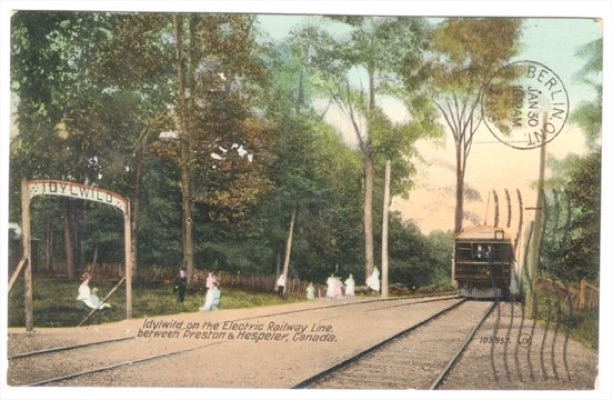
Most of Idylwild Park lost to history - after all, the railway only opened the park between 1899 and 1916. But according to the following quote and picture from the Wikipedia page, it must have been quite a spectacle:
“A wooded area with tall elms, maples and evergreens - a perfect setting for one of, if not the, most popular playground, picnic and recreational centres in the district. Popular dances of the time included quadrilles, waltzes, two-steps and the cake walk. It was not at all uncommon for the railway to shunt in from Preston Junction a train load of picnickers from as far away as Hamilton, bringing hundreds to enjoy the great out-of-doors in the wilds of Idylwild.” - O.A. Kummer
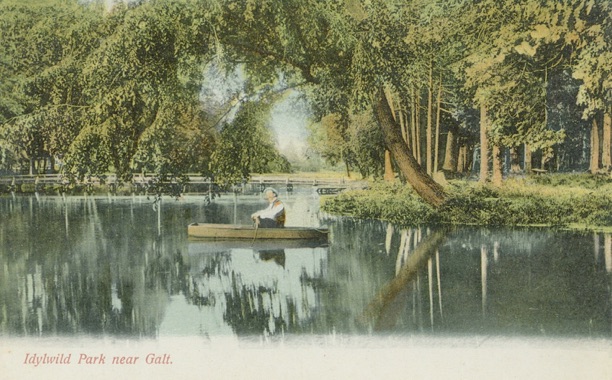
Another picture of Idylwild Park from the archives shows the recreational culture of that time:
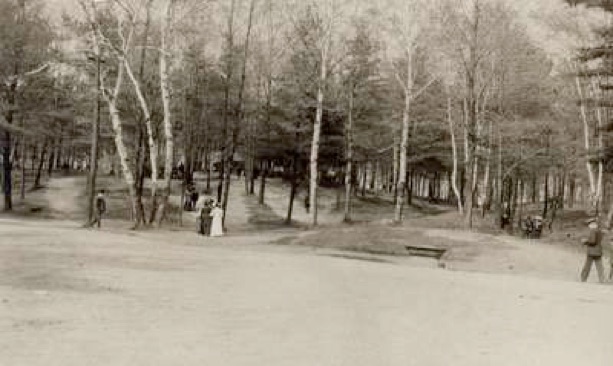
Although the park closed just over 100 years ago, there was plenty of other information I could find about the park online:
- It straddled the Speed River, using land on both bands and the islet between them.
- It was located on the Speed River, just north of where Hwy 401 crosses the river.
- The park had two dancing pavilions, a baseball diamond, swings, boardwalks, docks, a refreshment booth, and wooden bridges that allowed people to walk to the islet and from the islet to the other side of the river (these bridges were disassembled each fall and reassembled each spring to prevent damage from winter floods).
- It had the nickname “Mosquito Park", since it was surrounded by wetlands (and hence mosquitos in the summer).
- It was closed in 1916 due to reduced visitation during World War 1, growing popularity of the automobile, and the opening of the nearby Riverside Park in Preston.
- The part of the park on the south bank of the Speed River is now run by the Grand River Conservation Authority and abandoned electric railway on the south bank is now the Mill Race Trail. The islet and north bank is private property with some cottages and other dwellings.
Knowing that the entrance was somewhere along the former railway (now the Mill Race Trail), I decided to find out where it actually was based on what I knew from the pictures of the entrance. I quickly noticed two things: the wooden bridge that crossed from the south bank to the islet, and a large boulder (which should still be there today):
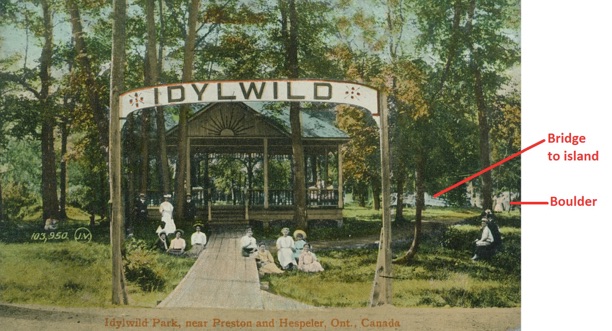
I then took my dog and GPS and explored every part of the area imaginable over a period of a week. At the end of the week, I noted that:
- Only part of the area is high enough to be part of the park (i.e. not wetland)
- One one part of the Mill Race Trail (former railway) has a wider section on the river bank side with gravel more than 6 inches underneath the soil (to match the railway bypass in front of the Idylwild Park entrance sign shown on the postcard).
- There are only a few boulders along the entire trail, and they are all in one small section within a few meters of each other. The one closest to the trail (former railway) looks very similar to the one in the picture above, and is just to the right of the railway bypass.
- The area behind the boulders happens to border the narrowest part of the Speed River between the south bank and the islet at an angle that matches where the wooden footbridge is in the picture at the top of this post.
Given all of this, it really isn’t that hard to pinpoint where the entrance to Idylwild Park was (including GPS coordinates):
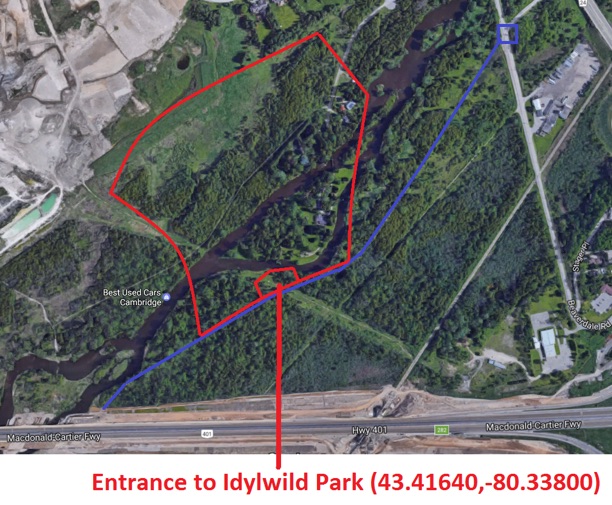
The blue line in the Google map shown above is the Mill Race Trail (abandoned electric railway), and the blue square is where you can enter this trail on Beaverdale Road.
The large red outline is the portion of the surrounding area that isn’t wetland (i.e. suitable for Idylwild Park, but I doubt all of the land on the north bank of the river was used for the park), and the small red outline next to the railway roughly maps to the visible area shown in the picture at the top of this post if you were standing on the railway (now the Mill Race Trail) and viewing the entrance. The right side of this area has the boulder hidden behind some cedar trees, and also borders on the south bank of the river that would have contained the wooden footbridge.
Also notice that there is a bright green line running straight through the area I identified as the entrance to Idylwild Park on the Google map above - this is a power corridor that now houses tall electrical lines. This power corridor also makes it much easier to find the entrance to Idylwild Park for casual hikers - simply find this corridor, and you’ll find where the entrance to Idylwild Park was. The pavilion in the picture at the top of the post would have been in the grassy area in the far upper-left of the picture below. You’ll find the boulder and south bank of the Speed River islet just beyond the cedar trees in the distance. Better yet, if you explore this area, you’ll find bits of what appears to be the remnants of 100-year-old concrete in various spots (perhaps serving as the base pegs of the pavilion or footbridge).
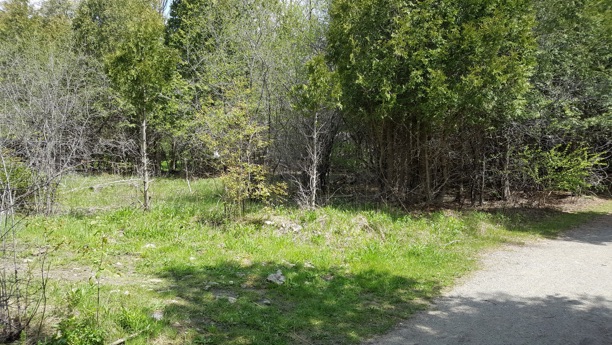
While the physical area has changed dramatically over the past 100 years, there is still a bit of the beauty of Idylwild left in the privately-owned portion of the park (the islet and north shore) - as you walk down the Mill Race Trail and stare out over the south bank of the river at the islet, you can’t help but notice the beautifully manicured lawns (as well as a single cottage and a blue moose statue). It’s almost as if you were looking at what the grounds of Idylwild Park must have looked like over 100 years ago when trains brought hundreds of picnic-goers to the area for recreation and relaxation:

